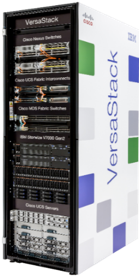It has been said that data is the new oil. Given the price of crude today, the metaphor seems to fit in that there is just too much data in the world, to the point we have no idea what to do with all of it. The data glut is driven by the sheer number of data-producing devices in use today due to factors such as Internet of Things, distributed application architectures, and as-a-service consumption models of the cloud.
The burden of managing all these devices and data is falling squarely in the heart of the data center, disruptively so. The urgency to modernize data center architectures and infrastructures has never been arguably stronger. Specifically, it requires data center to support higher VM densities, more powerful computational processing, a highly responsive and intelligent network, as well as a high-performance data storage foundation that form tightly integration solutions that can be rapidly deployed and provisioned at the speed of business.
Cisco and IBM took on these challenges head-on when they collaborated to launch the VersaStack™, a next-generation, converged infrastructure that combines the innovation of the Cisco UCS Servers , Nexus Switches and the IBM Storwize 7000 Storage solutions. The initial VersaStack Cisco Validated Design (CVD) solution was designed to address the on-premise data center use cases wherein the UCS servers scaled dynamically up to 160 servers and the Storwize 7000 array scaling up to multiple petabytes of storage. It quickly became the blueprint for cloud-ready enterprise data centers that needed exponential scale for the next decade.
Cisco and IBM followed this success up by adding the next solution – VersaStack for private cloud build-outs to address the needs for the XaaS market. This solution combined Cisco UCS servers, Cisco UCS Director, Cisco Nexus® 9000, and IBM® Storwize V7000 Unified system into a single highly automated and scalable system.
Fast forward one year to today, VersaStack solutions now extend from the on-premise data centers and private cloud solutions to a scale out architecture to address the needs of the distributed data and application use-cases. This comes in the form of two additional VersaStack solutions that have been added to thereby enable VersaStack solutions to address the modern distributed workloads—within and across multiple data centers. This newest solution is based on Cisco UCS Servers and IBM FlashSystem V9000 running vSphere 5.5, and seamlessly handles mission-critical, I/O-bound workloads.
In addition, Cisco and IBM are addressing the requirements of smaller IT environments for medium-sized businesses, branch offices and retail stores. For these organization, we offered a VersaStack solution based on Cisco UCS Mini Servers and IBM Storwize V5000 array running vSphere 5.5, optimized for remote office/branch office that:
- Monitors and manages the infrastructure remotely from a single management point
- Requires a much smaller footprint
- Offers new levels of RAS (service profiles to move a server image quickly) to give new levels of geographic RAS to the ROBO use case. For example, a failed server can be replaced automatically within minutes, not days.

The advantages of having a single UCS management interface regardless of location include : being able to spin up new VMs 85% faster1 and reducing cabling complexity 75%2 than legacy data center management methods.
A quote from IT industry analyst firm Enterprise Strategy Group (ESG) validates the benefits of the single-pane-of-glass UCS solution:
“VersaStack offers a vast improvement. It is a converged infrastructure solution that uses some of the most well-known and proven server, storage, and networking solutions in the industry. Pools of compute, network, and storage resources can be shared among many applications and reclaimed when not in use, driving utilization up and costs down. Pre-integrated and pretested, VersaStack saves IT from having to purchase the components individually, test them for interoperability, integrate them manually, and then test, refine, re-test, and finally deploy. Handling all this manually steals valuable time away from IT and application users, and will not provide the agility and flexibility that organizations demand. The same goes for ongoing management. VersaStack enables IT to manage all resources from a single pane of glass, and offers end-user self-service, saving organizations time and money.”1
In other words, enterprise data is more distributed than ever before and compounded with its exponential growth and ubiquity presents new demands on IT infrastructure. To manage this growth, enterprise IT teams have to operate far more efficiently, to do more with less and always faster. In this respect, perhaps the data is oil metaphor falls short. Unlike oil, the production of which can be manipulated downward, the data glut streams inexorably forward toward the Zettabyte Era and beyond. In the face of this daunting onslaught, Cisco and IBM teamed to produce the highly versatile and adaptable VersaStack that will serve as the converged infrastructure blueprint for the next decade. This is the kind of synergy that OPEC members can only dream about these days.
Good explanation of data technology advancing with Cisco and IBM partnership.
Very nice blog; good overview of our joint VersaStack solution – Happy Anniversary!
You mean there is collusion (synergy, wink) going on, like OPEC cartel, between IBM and Cisco?
Anyways, unlike oil, little proof that anyone actually buys VersaStack.
Great blog.. we´ll have a webcast based on this info – Happy Anniversary VersaStack!! https://ibm.biz/BdHuJ7